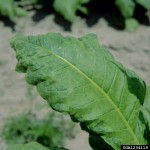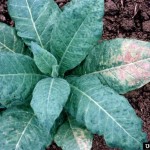Tobacco Mosaic Virus (TMV)
Recommended resistant cultivars are: CC 27, CC 37, CC 67, and CC 400
Pictures provided by R.J. Reynolds Tobacco Company Slide Set, R.J. Reynolds Tobacco Company, Bugwood.org and Clemson University – USDA Cooperative Extension Slide Series, Bugwood.org
Symptoms of Tobacco Mosaic Virus generally first appear as light green coloration between the veins of young leaves, followed by a “mottled” appearance of the leaf (alternate areas of light and dark green tissue). The plant may develop rough tissue which will burn the high heat associated with hot, sunny days. Symptoms on seedlings are generally much milder and are therefore easily overlooked. Stunting and mild mottling may be observed. As symptoms may be mistaken for other virus diseases like PVY or CMV, the first step in controlling mosaic is to be sure that the virus causing the mosaic symptoms is indeed TMV.
Tobacco mosaic virus is transmitted mechanically by any means that results in the virus coming in contact with injured cells of a host plant. The primary mechanism for this is contaminated worker’s hands or equipment that comes into contact with a healthy plant. For this reason there my be a larger number of TMV-infected plants in some rows, where transmission occurred during planting or cultivation practices. Contaminated hands can be freed of the virus by washing with a detergent. The virus can be inactivated on equipment by scrubbing it with a brush using detergent or by steaming. Although the virus is transmitted primarily on worker’s hands and equipment, anything that mechanically moves the virus from a source to a healthy plant can transmit it. Chewing insects, such as flea beetles and grasshoppers, are capable of transmitting the virus, but such transmission is very rare in nature. Seed may be infested with the virus, but seed transmission has not been proven.
The virus can live in the soil for long periods of time, normally in the roots, crop remains or other host plants. After infection, there is no cure or remedy against this virus disease, which prompts the need for preventive measures. The best technique to avoid TMV infestations is the use of resistant cultivars.
In the case of susceptible cultivars, when there are small numbers of infected plants in the field, the infected plants should be removed in order to prevent the disease from spreading. When growers have an infected field, all cultivation practices should always start in the healthy fields, and then progress to the infected areas. Equipment should be thoroughly cleaned after leaving infected areas.


